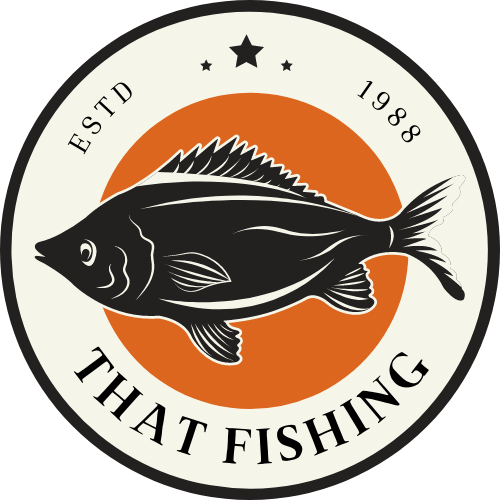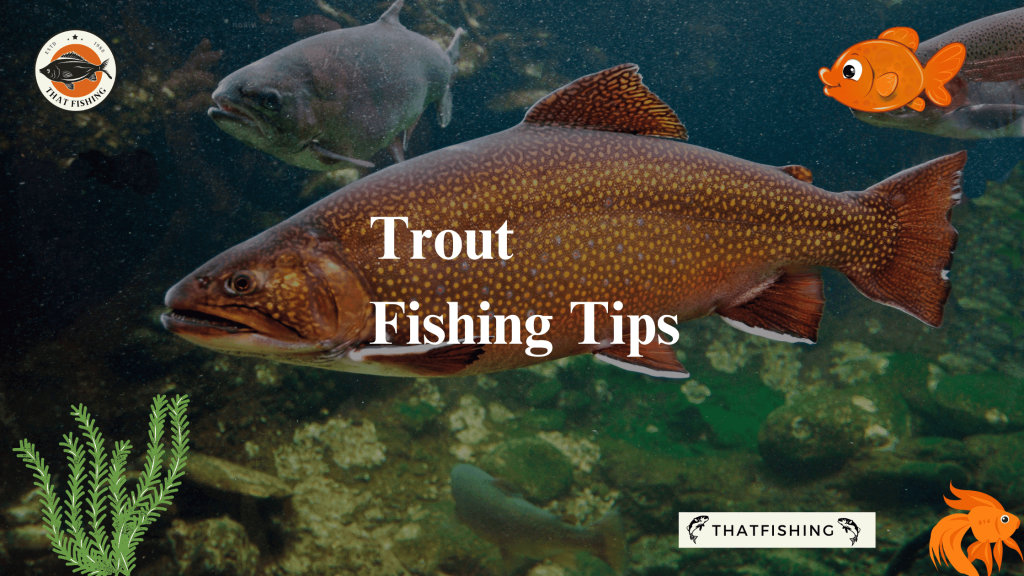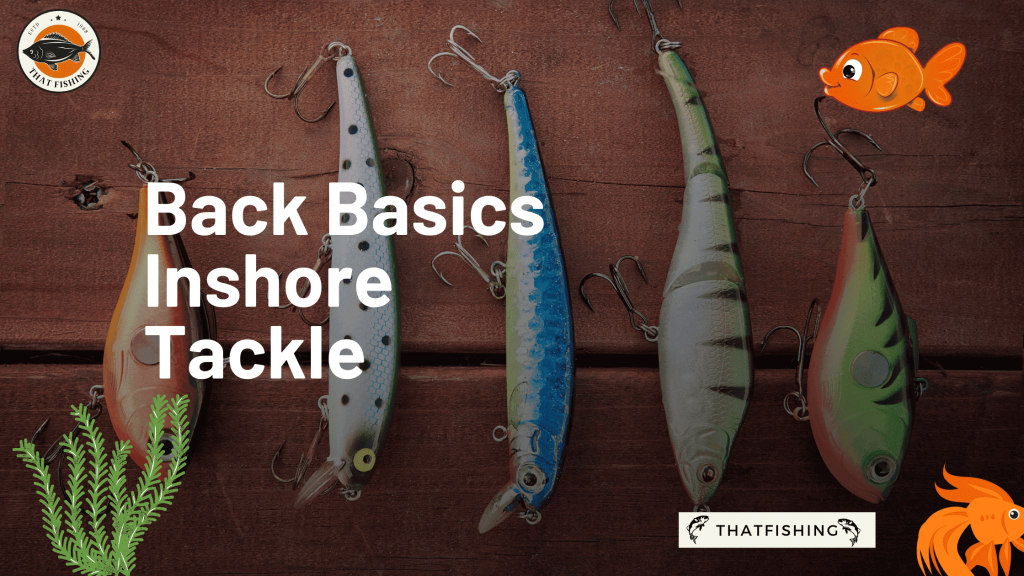Are you looking for some interesting information and valuable tips that will help you when fishing flies for trout? If you are, then we highly recommend reading every word on this website.
While I could try and spend 5 minutes or more of your time here informing you why Trout Fishing Tip will be a top resource for you, that is full of fly fishing tips, and we simply would rather get started.
So if you want to learn some great tips about fly fishing for trout, let’s get going.
The trout is something of an enigma. While it spends much of the year in river estuaries or the sea, it is rarely seen there.
However, every year when it returns to the rivers and streams to spawn, it attracts great attention from fishermen. This exodus to the river occurs in the spring and summer.
Trout Fishing Tip:
1. Trout Fly Fishing
2. Fishing Tip
3. Trout Fishing
4. Fly Fishing
Latest Trout Fishing Articles:
1. Lake Trout Fishing Tips (New!)
2. Fly Fishing Tips
3. Fishing For Trout
4. Brown Trout
5. Lake Trout Fishing
Trout Fishing Tip
Here are some tips for trout fishing :
1. Trout Fly Fishing
The trout must migrate high up into the rivers and streams to lay their eggs in areas known as redds.
These eggs hatch into small fish, Alevin, which are nourished by a small yellow yolk sack.
By the time the yolk is used up, the fish, which are now called Parr, are dependent on their own resources to feed.
At this stage, small anatomical changes occur that cause some trout to develop salt-secreting glands and begin to resemble salmon.
These are known as sea trout and eventually swim to the sea in search of greater food supplies.
The other trout remain in the rivers and estuaries and tend to be smaller than sea trout. They are known as brown trout.
The sea trout will return to the river of their birth to spawn in the coming season.
Many predators await the trout when they return to the sea, but some have been known to return to their home river on numerous occasions.
It is generally accepted that trout do not feed on their return to spawning grounds as they have enough reserves built up during the year to survive the trip. Does this raise the interesting question for anglers of why they bite the bait?
Some believe the distinctive patterns of the flies resemble the food the trout eat at sea, and upon seeing them, the trout bite them out of habit, forgetting that they do not need to feed.
Others believe the fish snap at the lure out of aggression.
They are not feeding on it but attacking it. Still, others believe the bait is taken out of a desire of the trout to keep its possible spawning ground free of intruders.
It is also possible that the trout is simply feeding.
2. Fishing Tip
While it is difficult to answer this question, it is interesting to bear it in mind when trying to get the trout to bite while fishing.
This question also influences the types of flies and the techniques used.
For instance, some anglers use a method known as lure stripping, where the intention is to mimic a small, rapidly moving fish.
Other flies, such as the Popper, Muddler, and Hugh Falkus’ Surface lure, attract fish by creating a disturbance on the surface of the river.
The dry fly method imitates a fully formed winged insect and is generally considered the highest form of fly fishing.
A floating line is used so that the lure remains on the surface of the water, and the angler must master the technique and concentration required to tug the line immediately after witnessing the underbelly of the fish as it takes the lure.
These are just some of the techniques used to trick the fish into thinking that various insects are in or on the water.
3. Trout Fishing
If you are considering trout fishing and would like to know more, the classic text recommended by anglers is Sea Trout Fishing by Hugh Falkus.
This masterpiece is worth the room on any fisherman’s shelf and will take you through the basics and on to advanced tips on this exciting sport.
However, it is possible to briefly go through the most important steps here.
- Do not start fishing until it is dark. Make plans in the daylight of how to fish the spot and wait until you hear the fish start splashing.
- Be comfortable with your equipment, the river, and the terrain you are fishing mentally so you can give your full concentration to the fishing.
- Concentrate on where you think the fish are, for example, the neck of a pool or where you see a lot of activity.
- Keep it simple. Use a single fly and short leader, as sorting out tackle problems at night can be tricky.
4. Fly Fishing
The equipment needed for trout fishing need not be complicated. You will need a good fly fishing rod.
Some respected brands include House of Hardy and Greys of Alnwick.
A fly fishing reel is a next item needed.
It is more than simply a repository for lines and should be durable, strong, and light.
Fly fishing uses a specific fly fishing line, and you will have to decide if you want a line that floats or sinks.
I recommend you try out both and see which you prefer working with. Some leader line will be needed between the line and the lure. Finally, good flies and hooks will be needed.
Anglers place a lot of thought and pride into their flies, and you can look forward to selecting the ones that fit your needs and personality closest.
If you like, you can use a fly box to store all your tackles safely and neatly.
I hope this basic information and advice has whetted your appetite to find out more and give trout fishing a go.
Many peaceful hours have been spent on the banks of a river trying to outwit and catch these enigmatic and beautiful fish.
Latest Trout Fishing Articles
Here are some latest trout fishing articles :
1. Lake Trout Fishing Tips (New!)
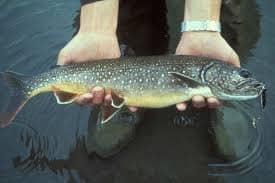
Lake trout fishing can be a fun and relaxing experience.
It’s a great sport to enjoy alone or with family and friends.
However, many people find that even the most well-planned lake trout fishing excursion can be nothing more than a peaceful jaunt on a quiet lake because they never actually catch any fish.
A few simple lake trout fishing tips can change all that! While these pointers don’t guarantee you’ll land a lake trout, they’ll greatly improve your chances.
KNOW YOUR FISH
Lake trout are the largest trout species. They range greatly in size and weight but generally weigh anywhere from 5 to 10 pounds.
There are exceptions, however, and it is not unheard of for anglers to pull up a lake trout weighing close to 60 or 70 pounds. In fact, the largest catch on record is a whopping 102 pounds.
But again, this is the exception, not the rule. Lake trout are typically brownish-grey in color and have cream-colored spots on their bodies that become more prominent during spawning.
They are normally found in cold, freshwater lakes that have well-oxygenated water.
Known by a variety of names, including grey trout, paper bellies, and salmon trout, they are quite popular in Canada and the Northern United States.
They feed on a variety of critters, including minnows, insects, crustaceans, and even small sunfish.
THE BEST EQUIPMENT
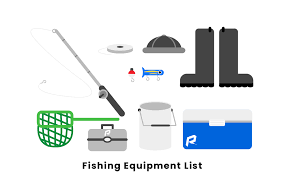
Rods and reels are essentially a matter of taste for any fisherman, and the choice is very subjective.
That being said when jigging for lake trout, you will probably want to use a baitcasting reel rather than a spinner, mainly because the bait cast will drop the lure more quickly than the spinner.
Some anglers prefer to use a spinning rod/reel for trolling because they believe the sensitive touch gives them an advantage.
Lake trout have a lot of fight in them, so a medium action rod is recommended unless you are planning on finding the 60-pounders, in which case you may want to consider using a heavy action rod.
Give yourself at least 300 feet of line so that you don’t get caught short when you hook a fighter.
Lake trout have very keen eyesight, so you might consider a fluorocarbon line rather than a monofilament since it sinks more quickly and is less visible underwater.
If you are using lures for jigging, try the lighter ones, especially gold and silver spoons, which work very well when coupled with live bait.
Plastic-tipped and pink jigs also work well. Some time-tested favorites include Little Cleos, William’s Warblers, and the Johnson Silver Minnow.
If you’re trolling, you’ll also want a three-way swivel so that your line won’t get tangled.
Also, for trolling or jigging, a gang hook, size 8 or 10, works quite well, especially if you’re using live bait. If you intend on trolling, you’ll also find a downrigger helpful for securing your rod to the boat.
Finally, if you’re fishing in unfamiliar waters and are serious about finding lake trout, you may want to invest in a depth finder, especially if you are doing late-season fishing when the lake trout retreat to lower depths.
LOCATION
As mentioned above, lake trout prefer the cold northern waters. They also thrive in water that is well-oxygenated, so look for lakes that are spring fed and not stagnant.
Most of the time, you won’t find lake trout too close to shore, so plan to spend your time fishing from a boat.
Of course, if you’re trolling, you’ll probably want a motorboat, but otherwise, for jigging, a standard rowboat will do just fine.
Lake trout are adaptive eaters, meaning that they will tend to adjust their diet according to the available food sources.
With that in mind, to increase your chances of landing a catch, know your lake.
Observe the food sources that abound in the area—minnows, insects, crustaceans, suckers, etc.—and choose your bait accordingly.
Choose lakes that have some depth to them.
During the warmer months, lake trout have been known to sit at around 100 feet. Also, opt for locations that are sheltered and not susceptible to windy conditions; lake trout prefer still waters.
TIMING AND WEATHER CONDITIONS
In the early spring, after the thaw when the water is the coldest, you will find lake trout swimming relatively close to the surface.
If the lake recently loses ice, the fish will be hungry and less discriminating in their choice of meals.
Hungry fish lurking close to the surface makes for some excellent fishing.
In the warmer summer months, the lake trout tend to swim at deeper depths and are generally less active.
They still need to eat, though, but if you’re going to catch them, you will have to send your lure deeper and have a bit more patience.
In many areas, lake trout season ends in mid-September, but in areas where the temperature drops in early fall, you can still get those lake trout, and, since the water is cooler, you’ll probably find them closer to the surface again.
October is the spawning season, and in many areas fishing for lake trout is not permitted or is on a catch-and-release basis only.
In any season, but especially in the spring, opt for overcast days since the lake trout sometimes shy away from the sun.
Fish between dawn and mid-morning or at twilight, when feeding is most active.
A gentle rain can help draw the fish to the surface because the rain will bring down tasty insects that will draw out minnows and other small fish.
This banquet will serve to tempt the lake trout out for a meal.
However, since trout generally prefer calm waters, stormy, windy conditions that churn up the water will have the opposite effect.
JIGGING
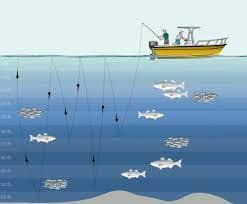
Jigging for lake trout means using a lure in the water and manoeuvring it so that it mimics the actions of an injured fish—easy prey for the lake trout.
The types of lures you might consider are mentioned above, but regardless of which type you use, you need to get involved in making them work.
While the water currents will give the lure some life, once you cast your lure onto the bottom, don’t just let it rest there.
Using slow, random movements, raise and lower your rod or sway it from side to side.
It is important that you vary the movement so that your lure will take on the erratic motion of injured prey.
Your lure will work even better if you attach live bait such as minnows, crayfish, or smelts.
Even worms will do. Opt for manure worms over nightcrawlers.
TROLLING
For trolling, anglers will toss their line in the water and slowly motor their boat, pulling the line behind them.
This process works well for lake trout during the summer months when they are swimming at lower depths and hiding among natural barriers such as roots, rocks, or lake scrub.
The faster the boat goes, the higher the hook and lure will ride in the water, so if you are fishing for deep trout, it is best to keep your troll at a slow and leisurely pace.
A two to three-ounce weight attached to your three-way swivel will produce good results.
To set up the troll, let the line out a few feet at a time until you feel the weight hit bottom, then take it up a foot or two and begin to troll.
Make sure you leave a lot of lines between the motor and the lure (at least 20 to 40 feet).
Lake trout will get spooked by the motor, no matter how quiet it is, and the space between the boat and the lure will give them a chance to regroup.
Again, as with jigging, your lure will be even more attractive with live bait or a small piece of fish attached.
LANDING YOUR CATCH
Smaller lake trout tend to hit and run with the lure, but larger ones take their time.
They may follow your bait for a while on a troll, then take it and swim off at a leisurely pace.
Consequently, if you feel a snag on your line as you’re trolling, it might not be a tree stump but rather a nice big lake trout.
Be prepared, though, because even if you begin to bring in your catch without much of a fight when the trout gets sick of the hook in its mouth, you’re in for a battle.
Lake trout are notorious for turning and diving and will often deep dive several times before they tire out.
Wait for the fish out, and don’t reel it in until some of its fights are spent. When it gets close enough to the boat, net the fish and bring it in.
Handle with care, though, because lake trout have sharp teeth and are not fond of being handled.
6. Fly Fishing Tips
Fly fishing is a lot like the dating game.
You need to understand your quarry, have the right lure, know how to cast your line, and dress properly for the occasion.
The satisfaction of reeling in a big trout makes all the preparation worthwhile.
Whether you release or cook your trout, it’s all about the thrill of the chase.
Here Are Our Top Fly Fishing Tips
According to an old Irish proverb, “Listen to the sound of the river, and you will get a trout.
” Fly fishing is done in saltwater, rivers, lakes, ponds, and streams.
Different types of trout are found in various locations.
With fly fishing, you need to hit the spot and avoid random casting. Most trout anglers only use about 35 feet of line.
You want to imitate nature, blend in with your surroundings and float your lure over the spot of the feeding fish.
Finding The Right Types of Trout.
The type of trout you catch depends on where you go fly fishing.
Rainbow trout are beautiful and challenging to catch. In days gone by, rainbow trout were only found in US coastal rivers on the West Coast.
Today rainbow trout are in freshwater all throughout North America.
trout have a red stripe and black spots.
This is the trout trophy of choice for most fly fishermen, as rainbow trout are renowned for long runs and acrobatics to avoid getting caught.
Brown trout, originally from Asia and Europe, are now found in the Rocky Mountains and Eastern and Midwestern streams in the United States.
Brown trout are particularly cunning, and simple fly fishing tactics often fail.
Often brown trout take long runs, purposefully tangle your line and even break free, making them the subject of many fish tales about the “one that got away.”
Cutthroat trout are found in the Pacific Northwest and some alpine lakes and are smaller than rainbow or brown trout.
Fly fisherfolk must travel to remote areas to catch cutthroat trout, but they are easier to catch once you finally get there.
Golden trout are found in remote lakes throughout the United States.
These small, uncommon trout are golden in color and difficult to catch.
Because there are few golden trout, most anglers catch and release them for the joy of the chase.
Brook trout are found in the Western United States, Rocky Mountains, and Canada.
This good-looking fish is gray with red, cream, and orange spots.
Beginning anglers discover brook trout are the easiest to catch, making them a great way to build your self-esteem for tricker trout.
To effectively fly fish for trout, you need to have a window into a trout’s world.
Trout do not see the world the way we do. Whether you fish for hatchery-born trout or in the wild, knowing about the trout’s senses will help you catch one.
Trout Sight.
Trout have cone-shaped vision.
The deeper trout go into the water, the more they can see. Trout can see color and shadow, which is why lures must be so realistic.
When you cast, you must drop the fly upstream so its floats naturally down the river.
If a fly suddenly appears in the trout’s cone of vision, this smart creature will avoid it.
Cheap flies you buy may have the right colors, but if their profile doesn’t look like a fly, you won’t catch a trout.
Trout Scent:
Trout have a keen sense of smell underwater. If your fly smells strange, trout won’t approach it.
The latest fly floatants and cleaners are made to mask possible chemical odours. Don’t wear aftershave or cologne when you go fishing.
Even deodorant, cigarette smoke odours, and glues can deter fish.
Trout Hearing:
Trouts hear through frequency receptors and movement receptors so they can find food in all types of water. Fish cannot hear voices outside the water if you talk.
Trout will hear oars banging on a boat, loud splashing or wading into the water and items that drop in the water.
Casting a fly gently is the best way to attract a trout. If your fly slaps into the river, the trout is likely to go away.
Alluring Trout Lures
Trouts are carnivores in search of flies, grasshoppers, beetles, dragonflies and snails.
Flies are made with feathers and fur to imitate these natural creatures in their own habitat.
Basic trout flies include:
Dry Flies: Dry flies imitate surface riding insects such as grasshoppers and dragonflies.
Dry flies are the most widely used in fly fishing because all anglers want the rush of catching a trout on the water’s surface.
Wet Flies :Wet and nymph flies are particularly effective because 80 percent of trout’s feeding happens underwater.
Bead heads and other weighted trout flies are productive ways to catch fish.
Streamers :Use streamers to catch those fast, aggressive trout. Streamers represent patterns such as woolly buggers and are weighted to hit quickly.
Emergers : Trout love to strike insects transforming from nymph to adult. Emergers imitate midges, mayflies, and caddis to catch trout.
Casting Your Line : Casting is a practiced art and should be done before you go fishing. Basically, you position your rod over your shoulder.
Start casting with a quick acceleration to the 10 o’clock position while you release the button then stop.
Make sure your movements are smooth and accurate.
Practice by tying a ¼ ounce weight on your line when you start.
Watch out for children, pets, fences and everything else that might be behind you when you practice casting.
More Fly Fishing Tips : Here are some bonus fly fishing tips for successfully bagging trout to take home or release:
What To Wear – And What Not To Wear: Wear colors that blend into the natural surroundings, such as brown or gray.
Steer clear of white, red, orange, and other bright colors.
Wear boots with decent traction and a hat or sunglasses so you can see what you’re doing in the sun.
It’s All In The Approach. Try to get behind the sun, so you don’t cast a shadow on the trout.
Avoid standing up straight. Go down low and blend into the environment to sneak up on tricky trout.
Smaller Is Better: Use light gear and bait with the smallest lures. Spoons and spinners should be no larger than ¼ ounce in most instances.
Use the hook and bait up to a size 10. When using minnow-like plugs, they should be under 4 inches long.
In some areas, there are regulations regarding hook size and type, so be aware before you cast.
Stay Sharp: The sharper your hook, the easier it is to set on the fish.
Get That Trophy, Trout. Find rainbow trout feeding near big rocks, bridge abutments, and fallen logs.
They travel in fast-moving water, so you can find them at the head of rapids and waterfalls.
Cast using 25 feet of line in graceful loops that look like a “U” on its side.
Be Color Coordinated. In low lighting or colored waters, use fluorescent green or fluorescent orange.
In cloudy weather with medium lighting, use gold, copper, red or orange.
Get Permission. Always make sure you know the regulations before you fish in a certain area.
Have all required permits and licenses so nobody can break up your fishing party when you finally get that trout on your line.
Pump It Up. When you get a fish on your line, lean back, then pull and draw in a pumping motion to keep the fish on your line.
Grip the top of the handle and not the middle so your rod won’t break.
Get Real. Your flies must be realistic, which is an art in itself. If you can’t make your own, buy the best. Fake-looking flies won’t catch smart trout.
Toothpaste In Your Tackle Box. No, fish are not put off by unpleasant breath, but they are sent away by the smell of your hands.
Many anglers clean oils, odors, and other scents off their hands by using toothpaste, so keep a tube handy in your tackle box.
Fly fishing is about more than just catching trout. Your lures, presentation, casting, and technique are all part of the fly fishing experience.
The satisfaction of catching a trout with the right fly is often considered equal (or better) than finding the perfect partner in the dating game.
With these fly fishing tips, you can stop wishing and start fishing!
7. Fishing For Trout
Top Tips to Help You Catch More Trout
Are you tired of your friends boasting about how many trout they have caught? Are you weary of going home empty-handed after a day on the water? We have some secrets and tips to ensure that you have many more good days than bad when out fishing for trout.
The Types of Trout
When we discuss trout fishing, we are referring to typical trout species that can be caught within the United States.
The usual species to be found are the Bull, Cutthroat, Brook, Brown, and Rainbow Trout.
Fishing for any of these species is similar though you may want to read up on each of the species in order to have as much knowledge as possible about their habits.
The Size of the Gear
When you are fishing for trout, your gear and bait size matter.
Using the lightest gear as well as bait is recommended.
Unless your area has monster trout, as happens to be in the Midwest, the lighter, the better, your hook and bait should be no more than size 10.
The smallest lures are recommended as well.
Spinners and spoons that are larger than a quarter ounce are often too big.
If you are using minnow-type plugs, keeping the size below 4 inches will net you plenty of trout.
What You Wear
Most trout fishing is done in streams and rivers.
Often the angler must wade in the water in order to catch some trout.
You will be surprised to note that the color of your clothing makes a difference.
Wear colors that are drab and won’t stand out, like white and bright colors. Remember, the fish can see you, so you want to blend in with the background.
Even your shirt colors matter, so instead of wearing an orange or red one, wear grey or brown.
Fish Can Smell Too
All trout have a great sense of smell and the ability to detect odors that aren’t natural to their environment.
Anglers must beware of how their hands smell as the smell transfers to whatever they touch; in this case, it is gear and bait.
Most trout take a sniff of the bait before they bite, and if you smoke or have used heavy cologne without washing your hands, the fish will definitely smell it.
If you are a smoker, after you are done, grab some dirt or weeds near you and rub your hands on them so as to get rid of any unnatural odors.
Unusual-smelling hands will cost a fisherman a ton of bites!
Trout are Pretty Smart
When you are fishing for trout, you must keep in mind that these types of fish are quite intelligent.
When you are deciding upon how to present your bait, you should do it in the most natural way possible.
Pre-tied gang hooks allow the fisherman to make live bait seem natural.
Whether you are fishing in a stream or a river, the presentation of the bait is one of the most important aspects of catching trout.
More Tips for Trout Fishing
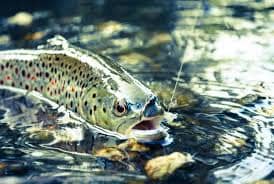
It is thought that when you are fishing for trout, the closer you are to the rapids, the better. You also need to be patient when you are trout fishing.
Keeping noise to a minimum will net you more bites than if you are busy talking to your neighbor while you are angling.
Make sure you know what the weather will be like before you leave so you can bring along the proper clothing.
Be sure you have all licenses and permits with you so as to avoid getting a ticket.
Trout fishing has been called a sport by many, but it is a passion for most. No one wants to come home empty-handed, so follow these tips and see if they don’t net you plenty of trout for the frying pan.
8. Brown Trout
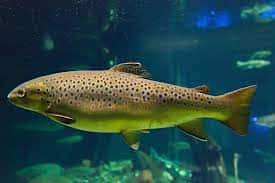
Native to Europe, the Brown Trout is a freshwater fish that derives from the salmon family.
Today, Brown Trout can be found in Asia, New Zealand, North America, and South America. American anglers have the best luck catching fish in U.S. trout streams, brooks, lakes, and in the Rocky Mountains.
Closely related to the Sea Trout, the Brown Trout is a brownish or butter-colored fish with rusty red and black spots that line its body laterally.
While Sea Trout and Brown Trout are of the same species, the main difference between the two fish is the Sea Trout is a saltwater fish.
Brown Trout are generally medium in size and can weigh more than 40 pounds.
In smaller rivers, however, it is common for the mature Brown Trout to weigh only 2 pounds or less.
According to the International Game Fish Association, the “all tackle” record Brown Trout was caught from the Little Red River in Arkansas in May 1992.
The trout was reeled in by Howard “Rip” Collins and weighed 40 pounds, 4 ounces.
The Brown Trout is a tasty fish that requires very little flavoring. It is best prepared grilled or barbecued.
Some fish-eaters also enjoy poaching.
The life expectancy of a Brown Trout is several years. However, as with Atlantic salmon, many of the males die after spawning.
Even more of the females, less than 20 percent, are recovering from spawning.
Today, some Brown Trout are raised in hatcheries, but most are still native to the areas they live in.
This is because the Brown Trout is harder than the more desirable Rainbow Trout to spawn artificially.
Brown Trout are opportunistic feeders that are active both day and night.
Their freshwater diet usually entails invertebrates from the stream, frogs, small fish, and insects flying near the surface of the water.
Their desire for insect larvae, nymphs, and pupae makes the Brown Trout a target for fly fishing.
Known as a clever fish, the Brown Trout has a savvy ability to outsmart both novice and professional fishermen.
If an angler is lucky enough to hook a trout, he is then presented with a set of problems.
Unlike its cousin, the Rainbow Trout, the Brown Trout does not flop around as it is reeled in.
Instead, the fish does its best to get the line tangled up in various obstacles in the river.
The fish’s mission is to snap the fishing line and escape the fisherman.
If it doesn’t succeed in snapping the line, the trout will then take to the air, much like the Rainbow Trout, as a final effort to regain freedom.
Because light tippets and tackle are commonly used when fly fishing, the Brown Trout has a good chance of escaping this scenario.
It is believed the Brown Trout will be the primary trout species of the future.
Because of their intelligence, this fish is resilient and has a strong desire to live. They also have the ability to live in warmer waters than that other trout.
These waters provide better nutrients for the fish, making them larger and stronger.
Lastly, Brown Trout are resistant to Whirling Disease, allowing them to reside in areas the Rainbow Trout cannot.
When considering our warming climate and drought-ridden waters in the U.S., it only makes sense that the Brown Trout, in the future, will be able to thrive in areas other fish will suffer
9. Lake Trout Fishing
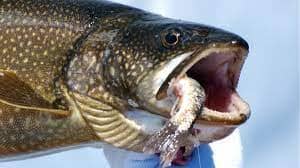
Soaking for lake trout this time of year, when lakes in cold weather climates are losing their ice caps, is very popular.
After the ice has cleared, lake trout are in the shallow water and hungry. They are no longer confined to deep water without as much to prey on.
Trout fishing is the rage among people who live close to these lakes, and it is also fast becoming a destination for vacationers who love trout fishing. So what can you do that others don’t catch the most trout to your liking? Here is a list of suggestions:
- Scoop up some sucker fish or mullets as your main bait for the trout. Fishermen, who net large numbers of suckers during their spring spawning runs, regard the suckers’ arrival as the beginning of the fishing season.
- At this time of year, it’s best to soak or use dead bait when you do your lake trout fishing. Lake trout look for weakened bait or bait that did not survive winter because they want an easy meal due to their hunger after a long winter.
- They are less willing to go after lures or live bait. The trout’s excellent sense of smell also makes stationary bait a good draw. Experienced fishermen believe a novice angler with simple means while shore fishing can catch as much trout as professional anglers who use expensive equipment in high-priced boats.
- If trying to put a few trout on the bank, use a simple slider-sinker rig with a walker sinker or egg-sinker, swivel shot, and a 3-foot leader with a No. 2 to 8 treble hook.
- The rig can include bait such as sucker meat or dead minnow, or herring, and then cast off the shore. Simply prop the rod up using a forked stick with the reel bait open.
- Make sure the hooks you are using are very sharp. You can use a file to hone the hook or purchase laser or chemically sharpened hooks.
- Using a fluorocarbon leader between the sinker and hook is recommended because it offers decreased line visibility and increased abrasion resistance.
- Land points, islands, and sand flats near deep water are good points for soaking.
- The most commonly used soaking rod is the 6V4-foot spinning rod and a reel with a 10- to 12-pound test line. An 8-foot rod offers more casting distance and provides a wider sweep when the hook is set.
- Match the bait size to the average trout in the lake. The common size is a 4- to 5-inch slab of sucker meat with its skin or a minnow.
- “Beer Canning” is a popular form of soaking. The rod is propped up or laid flat on the shore. With the reel’s bail open, the line is wrapped around a beer can – or soda can, if you like – a few times.
- When the trout takes, the can will tip over, signaling to the angler it’s time to get to the rod. The line will slip free, but only until the angler gets to the rod.
- Other anglers simply watch for the line to move abruptly when the trout takes. Some rod tips also come with a bell that helps signal the catch.
- Lake trout, also known as “Lakers,” usually cruise a large area along the coast, so the wait for a school of trout to come to your area might be a while.
- If no action occurs, reel in your bait every half-hour to make sure the bait is still rigged and it looks fresh. Reeling in the bait is an action that might actually attract trout to the area and uncover the bait from debris in cracks of rocks.
- If there is still no action after an hour, it might be wise to find another location.
- The prime spots for lake trout are usually around points off the shoreline. The trout generally cruise the deep-water area near the shoreline, but when they reach a land point, they often search the mud and sand for dead bait.
- The warmer the water surface, the more lake trout you will find. As the water starts to warm into the spring, the lake trout depart from the shallow water but are not into their summer habitat in the deep.
- Lake trout cruise the shoreline and shallow waters until early June in most northern lakes.
If these simple means of catching lake trout do not capture your fancy, high-tech fishing equipment is available to track where schools of trout are located.
Many of these units, such as the Lowrance LMS-350A, combine high-resolution liquid-crystal graphs with GPS.
Anglers who use boats swear by the vertical casting method of catching trout.
If positioned over the school of trout, you can expect to hook from the first drop as long as you stay on the school.
Predictably, at least one trout will swim up to intercept the spoon (or lure), causing the line to slack long before it reaches the bottom.
Using the high-tech equipment, you can see the trout on the graph rising to meet the spoon.
Whatever your form of attracting lake trout, you can rejoice that no better time than the present exists.
Mid-April is generally considered the start of the trout season because the warmer weather breaks the ice and causes the weary trout to stir for food, even near the shore, creating easy access for anglers.
Related Reads
